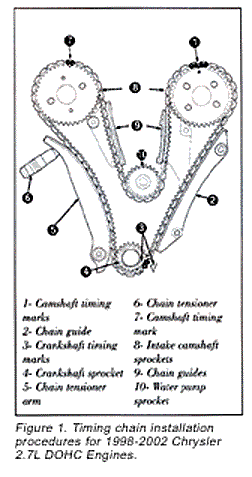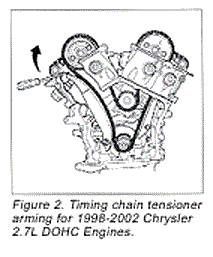Engine Builders: The following information may be helpful for your installers regarding timing chain installation procedures on 1998-2002 Chrysler 2.7L DOHC Engines. If the following procedure is not followed correctly, upon start up, valves will bend.
- Align crankshaft sprocket timing mark to the mark on oil pump housing. NOTE: Lubricate timing chain and guides with engine oil before installation.
- Place left side primary chain sprocket onto the chain so that the timing mark is located in-between the two plated links on chain.
- Lower the primary chain with left side sprocket through the left cylinder head opening. NOTE: The camshaft sprockets can be allowed to float on the camshaft hub during installation.
- Loosely position left side camshaft sprocket over camshaft hub.
- Align plated link to the crankshaft sprocket timing mark.
- Position primary chain onto water pump drive sprocket.
- Align right camshaft sprocket timing mark to plated link on timing chain and loosely position over camshaft hub.
- Verify that all plated links are properly aligned to timing marks on all sprockets.
- Install left lower chain guide and tensioner arm. Tighten attaching bolts to 28 Nm (250 inch lbs.).
NOTE: Inspect oil ring on chain guide access plug before installing. Replace O-ring as necessary.
- Install chain guide access plug to left cylinder head. Tighten plug to 20 Nm (15 ft. lbs.).
- For depressing the timing chain tensioner, refer to AERA TB 1709.
- Install chain tensioner into the right cylinder head.
- Starting at the right cylinder bank, insert a 3/8˝ square drive extension with a breaker bar into intake camshaft drive hub. Rotate camshaft until the camshaft hub aligns to the camshaft sprocket and damper attaching holes. Install the sprocket attaching bolts and tighten to 28Nm (250 inch lbs.).
- Turn the left side camshaft by inserting a 3/8˝ square drive extension with a breaker bar into intake camshaft drive hub and rotate camshaft until the sprocket attaching bolts can be installed. Tighten sprocket bolts to 28 Nm (250 inch lbs.).
- Rotate engine slightly clockwise to remove timing chain slack, if necessary.


For information on receiving all of AERA













